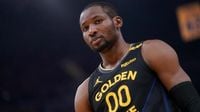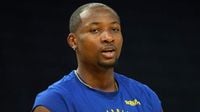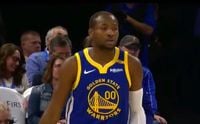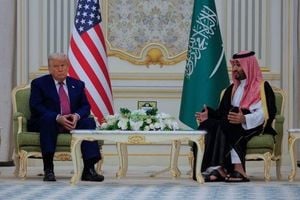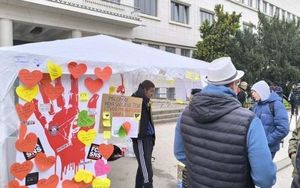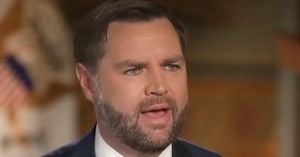The Golden State Warriors and forward Jonathan Kuminga are locked in a tense contract standoff that has not only dominated NBA offseason headlines but also put the franchise’s broader plans on hold. With both sides entrenched in their positions, the outcome of this negotiation could have ripple effects across the league and within the Warriors’ own roster construction for the 2025-26 season.
As of mid-August 2025, Kuminga remains a restricted free agent, and the gap between his desires and the Warriors’ vision has only widened. While the team has made it clear they view Kuminga as a valuable trade asset, the 22-year-old forward is seeking a contract that signals faith in his potential as a building block for the future. This fundamental disagreement has led to a stalemate, with neither side willing to budge on the key issue of contract structure and long-term commitment.
Multiple sources, including ESPN’s Anthony Slater, report that the Warriors have offered Kuminga a two-year, $45 million deal. The catch? The contract includes a team option for the second year and requires Kuminga to waive his no-trade clause. For Kuminga, who has felt undervalued during his tenure with the Warriors, this offer falls short of what he believes he deserves. He is pushing for a player option in the second year—a signal that the franchise sees him as more than just a piece to be moved in future trades. According to Slater, "Kuminga wants more of a player-friendly deal, more of a signal that he’s a building block, not a trade asset."
The Warriors’ hesitation to offer a player option is rooted in their desire for flexibility. They want a contract that is easily tradeable, should the right opportunity arise, and they’re unwilling to commit to a structure that could tie their hands. This approach has left Kuminga feeling boxed in, especially given his inconsistent fit in the starting lineup and the presence of established veterans like Jimmy Butler and Draymond Green. His dynamic scoring ability is undeniable, but questions linger about his perimeter shooting and willingness to embrace a more defensive, rebounding-centric role.
Despite the ongoing impasse, there have been renewed conversations between Kuminga and the Warriors in recent days. Slater noted, "There’s dialogue, but as you all know, talking doesn’t necessarily equal movement. They’ve shared contract concepts and opinions about the whole thing between each other this last week, dating back to last weekend." While these talks are a positive sign, they have yet to yield any significant progress. The possibility remains that discussions could fizzle out, leaving both sides back at square one.
One potential path forward for Kuminga is to accept his $7.9 million qualifying offer, play out the upcoming season, and enter unrestricted free agency next summer. This route would give him more control over his future and the chance to secure a more lucrative deal when the NBA’s financial landscape is expected to be more favorable for free agents. As Slater put it, "He’s pretty dug in. If this is going to be the best offer, if two for $45 million with a team option is gonna be the best offer he will see them in training camp on a $7.9M expiring qualifying offer which includes a no trade clause..."
Kuminga’s leverage in negotiations has grown as the offseason drags on, a rare advantage for restricted free agents in a summer marked by limited cap space across the league. The longer the standoff continues, the more pressure mounts on the Warriors to find a resolution—especially as their ability to pursue other offseason targets is hampered. The franchise has been forced to put moves for players like Al Horford, De’Anthony Melton, and Seth Curry on hold until Kuminga’s situation is settled. As NBA insider Anthony Slater observed, "August is a lot easier for people to just be like, 'OK, we'll get to you when we get to you'. September starts to get a little more uncomfortable in this entire situation. And that's where, I don't know if there will be movement or a little bit more angst in the Warriors or Kuminga's side, but September is where this could get a little dicey."
During the 2024-25 NBA season, Kuminga showed flashes of star potential, averaging 15.3 points, 4.6 rebounds, 2.2 assists, and 0.8 steals per game over 47 appearances (including 10 starts). He shot 45.4% from the field and 30.5% from beyond the arc, numbers that suggest both promise and areas for improvement. At just 22, Kuminga remains a tantalizing prospect—especially for teams willing to give him a larger role and more freedom to develop his game.
The Warriors, meanwhile, are weighing their options carefully. They have reportedly turned down sign-and-trade offers from the Sacramento Kings and Phoenix Suns, feeling the return wasn’t sufficient. The possibility of a dual sign-and-trade involving Chicago Bulls’ restricted free agent Josh Giddey has also been floated, but such a move is considered highly unlikely given the complexities involved. Golden State is also reluctant to include players like Moses Moody or Buddy Hield in any trade package, further limiting their flexibility.
For Kuminga, the choice is stark: accept a deal that positions him as a trade asset, or gamble on himself by playing out the season and testing the open market next summer. He reportedly believes he can command a $30 million per year contract in a more favorable market, a bet that could pay off if he continues to deliver on the court and stays healthy.
The situation is further complicated by the Warriors’ need to balance their immediate competitive goals with long-term roster planning. With veterans like Butler and Green anchoring the team, the window for championship contention remains open—but only if the supporting cast is cohesive and motivated. Kuminga’s uncertain status threatens to disrupt that balance, especially as training camp approaches and the urgency for resolution intensifies.
As September looms, the pressure is on both sides to find common ground. For now, the Warriors and Kuminga remain at an impasse, their futures intertwined yet uncertain. Whether this standoff ends with a new contract, a trade, or a one-year gamble remains to be seen. But one thing’s for sure: the NBA world will be watching closely to see how this high-stakes negotiation unfolds.
With the Warriors’ offseason plans hanging in the balance and Kuminga’s future up in the air, all eyes are on the next move—will compromise finally break the deadlock, or will the standoff drag on into the fall?
